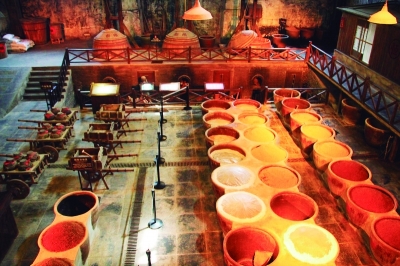(单词翻译:单击)
The Zhenjiang vinegar is made from sticky rice.
镇江香醋的原料是糯米
Production starts with soaking the sticky rice.
浸泡过的糯米经过高温蒸煮
The rice is first steamed in high temperatures until the starch component gets sticky.
淀粉充分粘稠
Then the rice is put under cold running water,so that the rice grains contract,
再用冷水冲淋降温 让饭粒收缩
making room for microorganism to propagate.
有利于微生物繁殖
Then it's time to add wine yeast for mashing, a prelude to fermentation.
拌入酒曲(麴),使淀粉糖化发酵成酒醅

Next is the critical step: acetic acid fermentation.
接下来是制醋的关键工序:醋酸发酵
This determines the outcome of the entire process in terms of both quantity and quality.
这决定了香醋的产量和质量
It takes 21 days to produce the acidity and another one month for esterification.
历经21天的演化,酸味产生了 再进入长达一个多月的酯化阶段
That's where the aroma of the vinegar comes from.
这个过程就是产生香味的秘密
Acid can contribute to the taste of dishes.
酸味能增加菜肴的鲜香
This is particularly TRUE when it comes to cooking meat.
尤其在烹制肉类时
Acidity can accelerate fibrosis of meat and make the meat more tender and delicious.
酸味加速肉的纤维化 肉质更加细嫩,口感鲜美
Apart from that, acidity can also boost digestion and appetite.
仅仅"酸"味本身 也能促进消化,增进食欲


